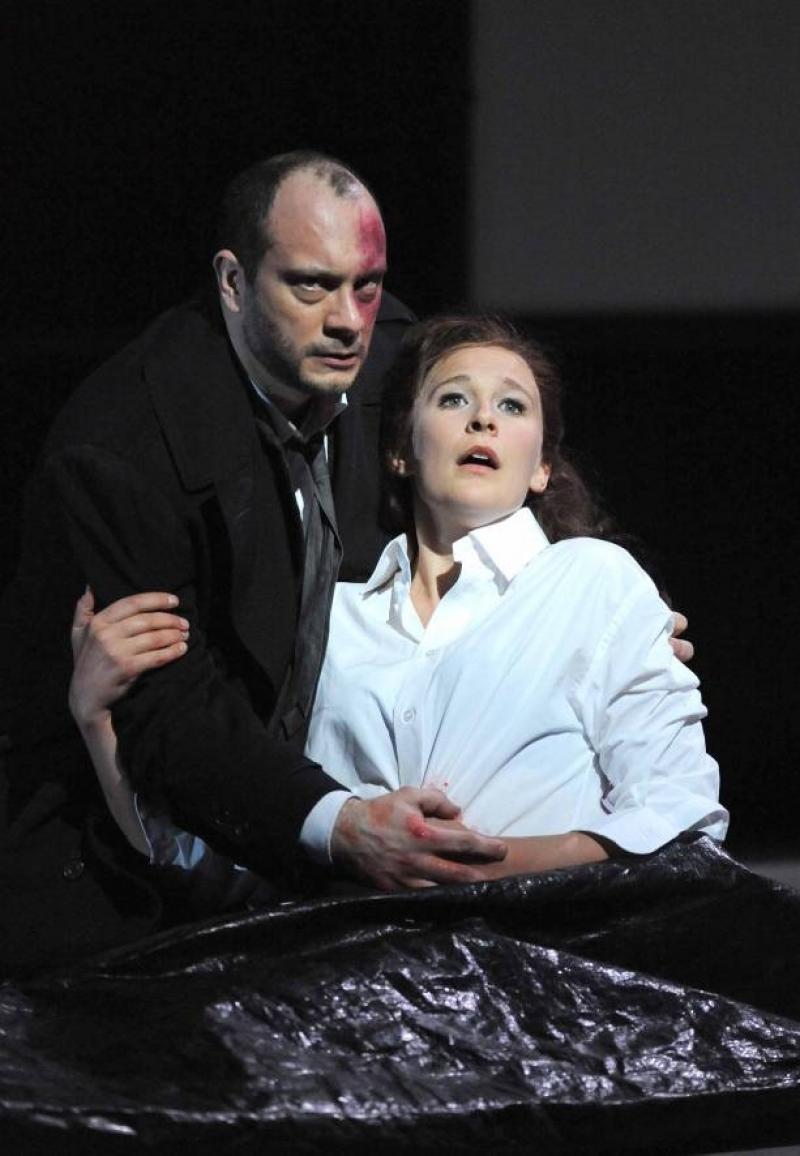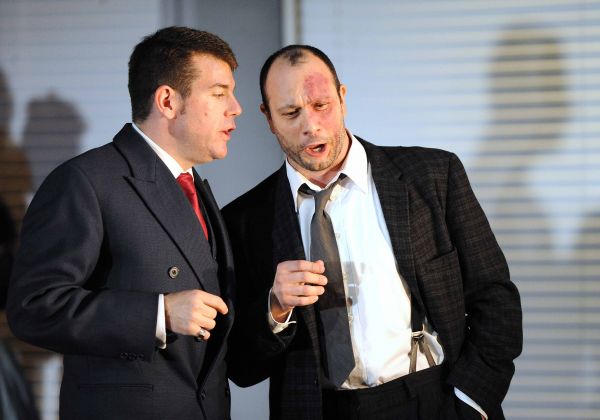Rigoletto, Grange Park Opera | reviews, news & interviews
Rigoletto, Grange Park Opera
Rigoletto, Grange Park Opera
A solid production in a magical setting makes for a memorable evening

They say that old sins cast long shadows, but these are nothing compared to the shadows cast by old productions. To set Verdi’s Rigoletto in 1950s America inevitably courts comparison with that operatic patriarch, Jonathan Miller’s New York Mafia reworking.
Grange Park has a reputation for being the loveliest of the country house operas, and there’s something about this grand old ruin, surveying a glorious Hampshire river valley, that gives the shivers that the more polished, domesticated delights of Glyndebourne and Garsington (I've not yet seen the new-look Garsington Wormsley) just can’t match. A crumbling bastion of the past, there’s something about the feudal grandeur of the place that feels right for Rigoletto, Verdi’s Renaissance tragedy of brutal mores and social caste.
Celebrating the appointment of LA’s new Chief of Police, we open in a flurry of peaked caps and shiny badges, the Duke alone distinguished by his civilian suit. Tightly waisted women drape themselves decoratively about the scene, barely distinguishable from the prostitutes of Act II; this is a world of men, and more particularly of white Christian men, as the entrance of Monterone (Andrew Greenan) makes clear.
 Casting both of the opera’s outcasts, court jester Rigoletto (Damiano Salerno) and wronged father Monterone, as Jews (Orthodox hair curls and a skull cap proclaim Monterone’s Orthodoxy, while a menorah dominates Rigoletto’s mantelpiece) underlines their separateness, but if there was a subtler point to be made about the particular milieu of 1950s LA then I missed it. Coming on top of Rigoletto’s deformity (here a livid birthmark covering his face) which already sets him visually apart, the issue of religion seemed to cloud the politics of a tale whose impact comes from its simplicity.
Casting both of the opera’s outcasts, court jester Rigoletto (Damiano Salerno) and wronged father Monterone, as Jews (Orthodox hair curls and a skull cap proclaim Monterone’s Orthodoxy, while a menorah dominates Rigoletto’s mantelpiece) underlines their separateness, but if there was a subtler point to be made about the particular milieu of 1950s LA then I missed it. Coming on top of Rigoletto’s deformity (here a livid birthmark covering his face) which already sets him visually apart, the issue of religion seemed to cloud the politics of a tale whose impact comes from its simplicity.
Challenged by a disproportionately wide stage, the difficulty of any Grange Park production is creating a balanced ensemble sound. Although conducted with efficiency and no little sympathy by Toby Purser, the English Chamber Orchestra never quite feel in command of this huge score. Compensating for orchestral numbers with brute force (the flutes in particular were lobbing their music like grenades at the too-close audience), theirs is a potentially effective chamber performance that attempts rather misguidedly to recreate a full symphonic effect. Sitting halfway back I would have begged both players and singers to have a little care for their audience; volume and weight of tone are only impressive if deployed appropriately, and the Grange Park auditorium is not the Metropolitan Opera.
That being said, there is much to enjoy in the quality of singing on offer. Marco Panuccio’s Duke (pictured above with Damiano Salerno as Rigoletto) has all the money notes (though he along with the rest of the cast might be discouraged from getting these out at every possible occasion in increasingly ornate cadenzas) and is at his best in full spate in "E il sol dell’anima" and "Questa o quella". Returning to the role of Gilda, Laura Mitchell offers a reliably pitched, if rather hard, vocal performance. There’s something of pressure in her sound that prevents her lovely spinto soprano from flourishing fully, giving it a rather unfinished quality at times.
Damiano Salerno’s Rigoletto is something of a cipher. While his vocal performance develops and settles noticeably into the Act II vengeance duet, his character proves a little unyielding. The move from public self to private – from vicious courtier to exiled father – which can be so moving, here lacked clarity. Fretful and angry from the start, he denies himself the opportunity to expose these qualities to us more gradually, denying us a share in his emotional process. Strong vocal support (and some solid acting) from Carolyn Dobbin’s Maddalena and Sparafucile (Timothy Dawkins) made for a delicious climax in designer Angela Davies’s Modernist boudoir.
Daniel Slater’s Rigoletto is not the production to rival Miller’s or to break new ground in this classic tragedy. This is a serviceable, sensible use of resources (inevitably limited in the impressively self-starting and precarious world of country house opera), and one that offers its audience the good night out that they all don bow ties and come out to Hampshire to find. For my money, however, if it were half the volume, it could be twice as good.
- Rigoletto at Grange Park until 1 July
- Find out what else in on at Grange Park this summer
Explore topics
Share this article
The future of Arts Journalism
You can stop theartsdesk.com closing!
We urgently need financing to survive. Our fundraising drive has thus far raised £49,000 but we need to reach £100,000 or we will be forced to close. Please contribute here: https://gofund.me/c3f6033d
And if you can forward this information to anyone who might assist, we’d be grateful.

Subscribe to theartsdesk.com
Thank you for continuing to read our work on theartsdesk.com. For unlimited access to every article in its entirety, including our archive of more than 15,000 pieces, we're asking for £5 per month or £40 per year. We feel it's a very good deal, and hope you do too.
To take a subscription now simply click here.
And if you're looking for that extra gift for a friend or family member, why not treat them to a theartsdesk.com gift subscription?
more Opera
 Albert Herring, English National Opera review - a great comedy with depths fully realised
Britten’s delight was never made for the Coliseum, but it works on its first outing there
Albert Herring, English National Opera review - a great comedy with depths fully realised
Britten’s delight was never made for the Coliseum, but it works on its first outing there
 Carmen, English National Opera review - not quite dangerous
Hopes for Niamh O’Sullivan only partly fulfilled, though much good singing throughout
Carmen, English National Opera review - not quite dangerous
Hopes for Niamh O’Sullivan only partly fulfilled, though much good singing throughout
 Giustino, Linbury Theatre review - a stylish account of a slight opera
Gods, mortals and monsters do battle in Handel's charming drama
Giustino, Linbury Theatre review - a stylish account of a slight opera
Gods, mortals and monsters do battle in Handel's charming drama
 Susanna, Opera North review - hybrid staging of a Handel oratorio
Dance and signing complement outstanding singing in a story of virtue rewarded
Susanna, Opera North review - hybrid staging of a Handel oratorio
Dance and signing complement outstanding singing in a story of virtue rewarded
 Ariodante, Opéra Garnier, Paris review - a blast of Baroque beauty
A near-perfect night at the opera
Ariodante, Opéra Garnier, Paris review - a blast of Baroque beauty
A near-perfect night at the opera
 Cinderella/La Cenerentola, English National Opera review - the truth behind the tinsel
Appealing performances cut through hyperactive stagecraft
Cinderella/La Cenerentola, English National Opera review - the truth behind the tinsel
Appealing performances cut through hyperactive stagecraft
 Tosca, Royal Opera review - Ailyn Pérez steps in as the most vivid of divas
Jakub Hrůša’s multicoloured Puccini last night found a soprano to match
Tosca, Royal Opera review - Ailyn Pérez steps in as the most vivid of divas
Jakub Hrůša’s multicoloured Puccini last night found a soprano to match
 Tosca, Welsh National Opera review - a great company reduced to brilliance
The old warhorse made special by the basics
Tosca, Welsh National Opera review - a great company reduced to brilliance
The old warhorse made special by the basics
 BBC Proms: The Marriage of Figaro, Glyndebourne Festival review - merriment and menace
Strong Proms transfer for a robust and affecting show
BBC Proms: The Marriage of Figaro, Glyndebourne Festival review - merriment and menace
Strong Proms transfer for a robust and affecting show
 BBC Proms: Suor Angelica, LSO, Pappano review - earthly passion, heavenly grief
A Sister to remember blesses Puccini's convent tragedy
BBC Proms: Suor Angelica, LSO, Pappano review - earthly passion, heavenly grief
A Sister to remember blesses Puccini's convent tragedy
 Orpheus and Eurydice, Opera Queensland/SCO, Edinburgh International Festival 2025 review - dazzling, but distracting
Eye-popping acrobatics don’t always assist in Gluck’s quest for operatic truth
Orpheus and Eurydice, Opera Queensland/SCO, Edinburgh International Festival 2025 review - dazzling, but distracting
Eye-popping acrobatics don’t always assist in Gluck’s quest for operatic truth
 MARS, Irish National Opera review - silly space oddity with fun stretches
Cast, orchestra and production give Jennifer Walshe’s bold collage their all
MARS, Irish National Opera review - silly space oddity with fun stretches
Cast, orchestra and production give Jennifer Walshe’s bold collage their all

Add comment